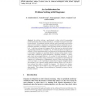Free Online Productivity Tools
i2Speak
i2Symbol
i2OCR
iTex2Img
iWeb2Print
iWeb2Shot
i2Type
iPdf2Split
iPdf2Merge
i2Bopomofo
i2Arabic
i2Style
i2Image
i2PDF
iLatex2Rtf
Sci2ools
DIAGRAMS
2004
Springer
2004
Springer
An Architecture for Problem Solving with Diagrams
In problem solving a goal/subgoal is either solved by generating needed information from current information, or further decomposed into additional subgoals. In traditional problem solving, goals, knowledge, and problem states are all modeled as expressions composed of symbolic predicates, and information generation is modeled as rule application based on matching of symbols. In problem solving with diagrams on the other hand, an additional means of generating information is available, viz., by visual perception on diagrams. A subgoal is solved opportunistically by whichever way of generating information is successful. Diagrams are especially effective because certain types of information that is entailed by given information is explicitly available – as emergent objects and emergent relations – for pickup by visual perception. We add to the traditional problem solving architecture a component for representing the diagram as a configuration of diagrammatic objects of three basic ty...
Artificial Intelligence | DIAGRAMS 2004 | Problem Solving | Traditional Problem | Visual Perception |
| Added | 01 Jul 2010 |
| Updated | 01 Jul 2010 |
| Type | Conference |
| Year | 2004 |
| Where | DIAGRAMS |
| Authors | B. Chandrasekaran, Unmesh Kurup, Bonny Banerjee, John R. Josephson, Robert Winkler |
Comments (0)

